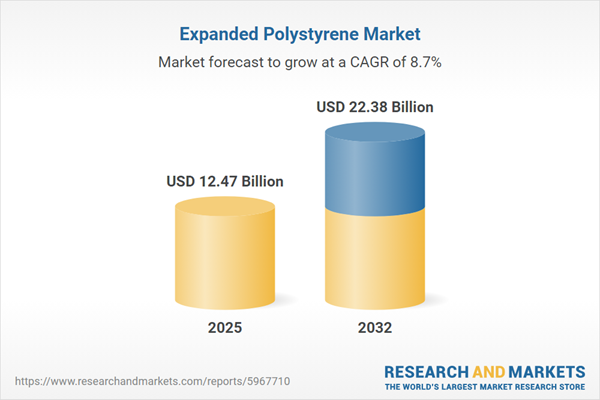Speak directly to the analyst to clarify any post sales queries you may have.
Senior executives in the expanded polystyrene market are shaping resilient business strategies in response to rapid regulatory, technological, and sustainability-driven transformation. Market intelligence is essential for anticipating risks, capitalizing on sector innovation, and meeting evolving stakeholder expectations.
Market Snapshot: Expanded Polystyrene Market – Growth & Strategic Outlook
The expanded polystyrene market continues to expand steadily, with global valuations progressing from USD 11.48 billion in 2024 to an anticipated USD 12.47 billion in 2025 and a projected USD 22.38 billion for 2032. This sustained growth is underpinned by manufacturing advancements, enhanced performance in core applications such as packaging, construction, and automotive, and the steady demand for high-quality insulation and impact protection. As end-users increasingly prioritize sustainability, the adoption of responsible supply chain management and advanced material engineering drives operational consistency and global market responsiveness. Businesses are concentrating on supply chain optimization and product reliability to secure strong positions across diverse international markets.
Scope & Segmentation: Strategic Focus Across the Expanded Polystyrene Market
- Application: Expanded polystyrene is utilized for cushioning, assembly, and insulation across automotive, construction, electronics, logistics, food packaging, refrigeration, furniture, and other consumer product segments, forming a backbone for key manufacturing and retail channels.
- Grade: Offerings span standard, high-density, low-density, specialty high-impact, and block copolymer grades. This variety addresses a spectrum of industry compliance needs, quality marks, and market trends.
- End-Use Industry: The material meets the requirements for automotive interiors and exteriors, commercial and residential construction, electronics assembly, furniture, and complex packaging, adapting easily to sector-specific shifts and innovation cycles.
- Form: Available in configurations including beads, pellets, panels, molded blocks, sheets, and loose fill, the product’s adaptability supports both large-scale infrastructure and tailored fabrication processes, ensuring integration with sophisticated supply chains.
- Distribution Channel: Distribution approaches include original equipment manufacturer agreements, contract manufacturing, partnerships with regional suppliers, and the use of digital vendor platforms. These channels foster broader reach and streamlined supply chain execution.
- Regional Coverage: Market analysis encompasses North America, South America, Europe, the Middle East & Africa, and Asia-Pacific, considering local regulatory climates and adoption rates. Strategies are tailored to the specific economic, technological, and policy environments of each region, enabling nuanced market entry and expansion planning.
- Key Companies Assessed: Key benchmarks include BASF SE, The Dow Chemical Company, TotalEnergies SE, INEOS Styrolution Group GmbH, Saudi Basic Industries Corporation, Evonik Industries AG, Trinseo SA, Sinopec Shanghai Petrochemical Company Limited, Formosa Plastics Corporation, and Greiner Holding GmbH. Comparative analysis of these organizations offers clear positioning and insights into prevailing market standards and leadership strategies.
Key Takeaways: Actionable Insights for Senior Decision-Makers
- Bio-based and recycled expanded polystyrene materials are increasingly prioritized to achieve sustainability goals and enhance reputation with both investors and regulatory bodies.
- Adoption of digital manufacturing and automation boosts agility, especially in high-volume sectors like packaging and construction where operational efficiency and responsiveness set market leaders apart.
- The transition to closed-loop and circular systems supports more resource-efficient operations, reinforcing supply chain stability and continuity amid global disruptions or material shortages.
- Strategic supplier collaborations and integration with technology providers help organizations rapidly adapt to changing requirements, ensuring that compliance and quality standards remain consistently high.
- Automation in sourcing processes and risk management supports resilience, protecting against region-specific supply interruptions and enabling uninterrupted production in various operational regions.
Tariff Impact & Supply Chain Adaptation
- Recent tariff adjustments in the United States prompt organizations to reassess sourcing strategies, prioritizing increased local production and cementing supply reliability within North American networks.
- Tools that offer supply chain transparency and risk analytics are being adopted to proactively manage cross-border uncertainties, maintaining dependable delivery schedules and consistent customer satisfaction.
- Utilizing hybrid and composite materials enables companies to address evolving regulatory frameworks and unlock new pathways for product innovation and regional expansion.
Methodology & Data Sources
This research derives its conclusions from direct input provided by senior industry leaders coupled with comprehensive secondary research, including published industry findings, regulatory documents, and academic analyses. A rigorous validation process ensures accuracy and relevance for executive-level strategic decisions in the expanded polystyrene market.
Why This Report Matters
- Offers structured segmentation and up-to-date trend analysis, equipping decision-makers with critical information for agile investment and market strategy formulation.
- Enables organizations to anticipate and respond to regulatory changes, leverage technological progress, and address sustainability imperatives within competitive contexts.
- Supports executives with clear frameworks for strategic realignment as market landscapes and operational dynamics evolve.
Conclusion
Strategic investment in sustainable technologies and advanced supply chain practices positions organizations for resilience and long-term competitiveness in the expanded polystyrene sector. The insights presented guide senior leaders in navigating ongoing industry change and unlocking value.
Additional Product Information:
- Purchase of this report includes 1 year online access with quarterly updates.
- This report can be updated on request. Please contact our Customer Experience team using the Ask a Question widget on our website.
Table of Contents
3. Executive Summary
4. Market Overview
7. Cumulative Impact of Artificial Intelligence 2025
Companies Mentioned
The companies profiled in this Expanded Polystyrene market report include:- BASF SE
- The Dow Chemical Company
- TotalEnergies SE
- INEOS Styrolution Group GmbH
- Saudi Basic Industries Corporation
- Evonik Industries AG
- Trinseo SA
- Sinopec Shanghai Petrochemical Company Limited
- Formosa Plastics Corporation
- Greiner Holding GmbH
Table Information
| Report Attribute | Details |
|---|---|
| No. of Pages | 193 |
| Published | November 2025 |
| Forecast Period | 2025 - 2032 |
| Estimated Market Value ( USD | $ 12.47 Billion |
| Forecasted Market Value ( USD | $ 22.38 Billion |
| Compound Annual Growth Rate | 8.7% |
| Regions Covered | Global |
| No. of Companies Mentioned | 11 |









